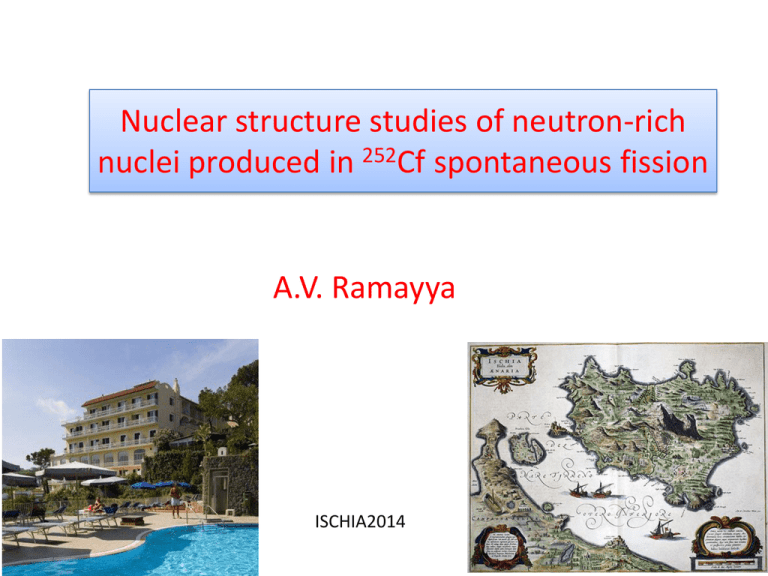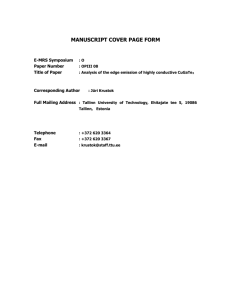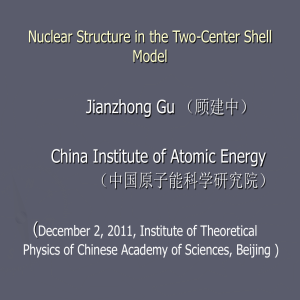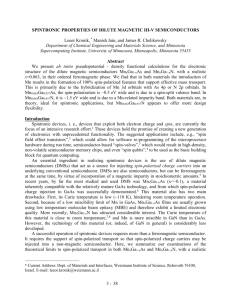Slides
advertisement

Nuclear structure studies of neutron-rich nuclei produced in 252Cf spontaneous fission A.V. Ramayya ISCHIA2014 134Sn 0n 0n 1n 118Cd 120Cd 2n 3n 4n 5n 6n 133Sn 132Sn 1n 119Cd 2n 118Cd 3n 131Sn 130Sn 131Sn 130Sn 4n 117Cd 5n 116Cd 6n 115Cd 114Cd Partner relationship between Cd and Sn isotopes produced from SF of 252Cf. Difficulties in Analysis • Approximately we have 200 nuclei. • If each nucleus emits ~30 g-rays we will have ~4500 g-rays. • Most of them will be in the energy range of 100-1000 keV. • Approximately four g-rays per keV. • We need triple g-ray coincidences. • To resolve them we need Gammasphere or such large detector arrays. Measured ggg and gggg coincidences • Coincidences with g-rays from the partner nuclei • Wherever possible, measured gg(q)data. 151,153Pr gated Y relative yields (from 252Cf fission data) 152Ce 426.4-487.6-538.5 578.2 487.6-538.5 Spectra of 152Ce showing the purity of a triple gate compared to a double gate with contaminations from 106Mo(538.7) – 142Ba(487.0), and 102Zr(486.6) – 148Ce(537.2) fission partners. Theoretical calculations by Napoli Theory group Aldo Covello As a two-body interaction between the valence nucleons, a realistic effective interaction derived from the CD-Bonnnucleon-nucleon(NN) potential were employed. 133Te 137,138Cs: 132Sn as a closed core and letting the valence protons and neutrons occupy the five single-particle (sp) orbits of the 50–82 shells. 93Sr: 88Sr as a closed core and letting the 5, 2, 4, and 6 valence neutrons, respectively, occupy the five levels of the 50-82 shell. As a two-body interaction between the valence nucleons, a realistic effective interaction derived from the Bonn-A nucleon-nucleon(NN) potential were employed. Single proton and neutron energies have been taken from the experimental data of 133Sb and 131Sn. C D B • Particle-hole states in 133Te are interpreted as coupling of a neutron h11/2 hole to the 134Te core. • Shell model calculations yield results for bands A, B, C and D in good agreement with the experimental data. A Phys. Rev. C 65, 034319 (2002) As a two-body interaction between the valence nucleons, a realistic effective interaction derived from the CD-Bonn nucleon-nucleon(NN) potential were employed. Single proton and neutron energies have been taken from the experimental data of 133Sb and 131Sn. Shell model calculations have been performed by using OXBASH computer code. As a two-body interaction between the valence nucleons, a realistic effective interaction derived from the CD-Bonn nucleon-nucleon(NN) potential were employed. Single proton and neutron energies have been taken from the experimental data of 133Sb and 131Sn. Shell model calculations have been performed by using OXBASH computer code. 137 55 Cs 138 55 Cs Shell model calculations indicated the important role played by the excitation of the valence protons outside the Z=50 middle shell and f7/2 valence neutrons outside the N=82 major shell. Assuming 88Sr as a closed core, performed shell model calculations. • If the intermediate state interacts with a magnetic field of sufficient strength for a sufficient length of time, then the experimentally observed correlation will be attenuated. • Specifically, for a constant magnetic field, B, a nucleus with spin I and magnetic moment m will precess about the direction of B with the Larmor precession frequency. L m N gB W(q) 1 A G P (cosq) A G P (cosq) theory 2 2 2 exp k theory k A Gk A theory 4 4 4 k 1 1 (1 2 ) 2 2 2k 1 q0 1 q N (qn ) A (1 A P (cosqn ) A P (cosqn )) exp 0 exp 2 2 exp 4 4 The Larmor Precession frequency, L L m N gB mean precession angle, m N gBHF f L BHF : nuclear hyperfine field : mean life time Phys. Rev. C 78, 044331 (2008) (Covello et al.) (Brown et al.) Fragment (ns) B (Tesla) 100Zr 0.78(3) 27.4(4) 0.32(5) 102Zr 2.76(36) 27.4(4) 0.25(4) 104Mo 1.040(59) 25.6(1) 0.28(6) 106Mo 1.803(43) 25.6(1) 0.24(3) 108Mo 0.72(43) 25.6(1) 0.3(3) 146Ce 0.36(4) 41(2) 0.30(6) 148Ce 1.46(9) 41(2) 0.37(5) g Generic level schemes of odd-A nuclei J=0,1,2,3 … (J+5/2)+ (J+9/2)- (J+5/2)- (J+3/2)+ (J+7/2)- (J+5/2)- (J+3/2)- (J+1/2)+ (J+1/2)- Mixing ratios of DI=1 transitions within a rotational band gR = ½(Z/A), gK : intrinsic g factor a: Nilsson coefficients, gl=0, gseff=-2.296 Q0 I f K 20|I i K 5 1 Eg ( E 2/ M1) 3 12 K 12 . 10 ( g K g R ) I f K10|I i K Q0 917 . 2/3 ZA g s gl 2 2 g K gl (al , K 1/ 2 al ,K 1/ 2 ) 2K 13/2 - 390.6 11/2 9/2 - 283.2 138.3 7/2 5/2 - 95.3 105Mo 95.3 5/2[532] -0.15 -0.12(3) Qo=3.06 138.3 5/2[532] -0.17 -0.25(4) 1961 Greiner and Faessler introduced improved rotation vibration model for deformed nuclei S.J. Zhu et al., Int. J. Mod. Phys. E18, 1717 (2009) Multi-phonon gamma vibrational bands have been observed in even-even nuclei 104,106,108Mo and 108,110,112,114Ru For odd A nuclei, the multi-phonon gamma vibrational bands involve the coupling of the single particle, collective vibrational and collective rotational motions. Comparison of Triaxial Projected Shell Model (TPSM) calculations for 105Nb with experimental data. g 2g PRC88, (2013) Y.X. Luo et al., J. Phys. G31, 1303 (2005) Are 116-126Cd levels good multi-phonon candidates? Studied decays of 116-126Ag to 116-126Cd at LeRIBSS, Batchelder et al. Studied spontaneous fission of 252Cf to levels in 116-122Cd, Luo et al. Earlier observations were interpreted as the vibrational spectrum Cd isotopes for Vibrational cases! Levels and B(E2) values expected for the harmonic quadrupole vibrator No Good 0+ or 2+ three-phonon candidates • Level schemes of Cd isotopes are expanded to high spins. 118Cd – 18+ for the ground band. Observed several side bands. 120Cd- 18+ for the ground band. Observed several side bands. 122Cd-14+ for the ground band. Not observed side bands. • Complimented with decay spectroscopy of 116Ag-126Ag. • 118-122Cd ground bands are a) 2 quasi proton holes (g9/2)-2 to 8+ b) 2 quasi neutrons (h11/2)2 above 8+. • Possible phonon bands are not definitive. Mass- and Z- gated spectrum on 151Pr (from 238U+9Be induced fission data) Our recent attempts. 151Pr level scheme obtained in the present work In the paper J. K. Hwang et al. Phys. Rev. C 82, 034308 (2010) band 1 and band 2 were assigned to 151Pr In the paper S. H. Liu et al. Phys. Rev. C 84, 044303 (2011) band 3 and band 4 were assigned to 152Pr In the paper T. Malkiewicz et al. Phys. Rev. C 85, 044314 (2012) band 1 and band 2 were assigned to 152Pr, band 3 was assigned to 151Pr, band 4 was assgined to 153Pr New results Thank You, Aldo, for your contributions to shell model calculations



![Semiconductor Theory and LEDs []](http://s2.studylib.net/store/data/005344282_1-002e940341a06a118163153cc1e4e06f-300x300.png)






![paper_ed1_12[^]](http://s3.studylib.net/store/data/007587747_2-1110b587fbe83635d767c66a07f9aff2-300x300.png)
